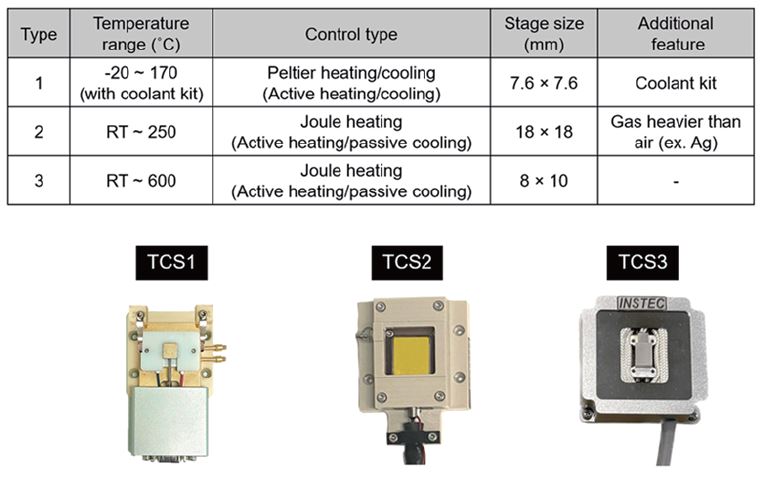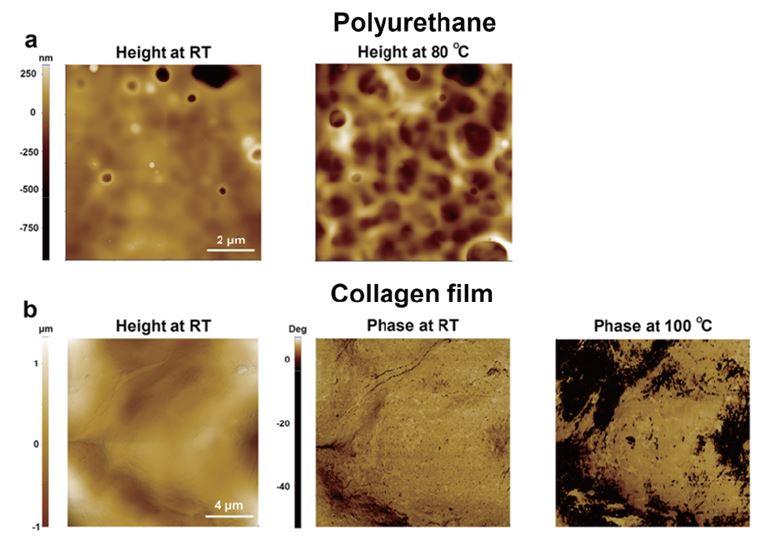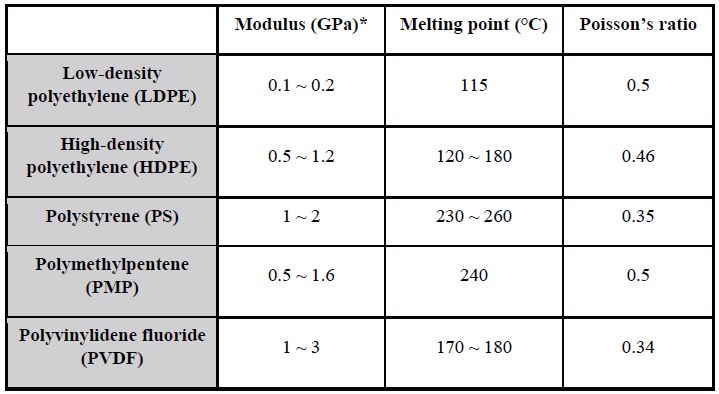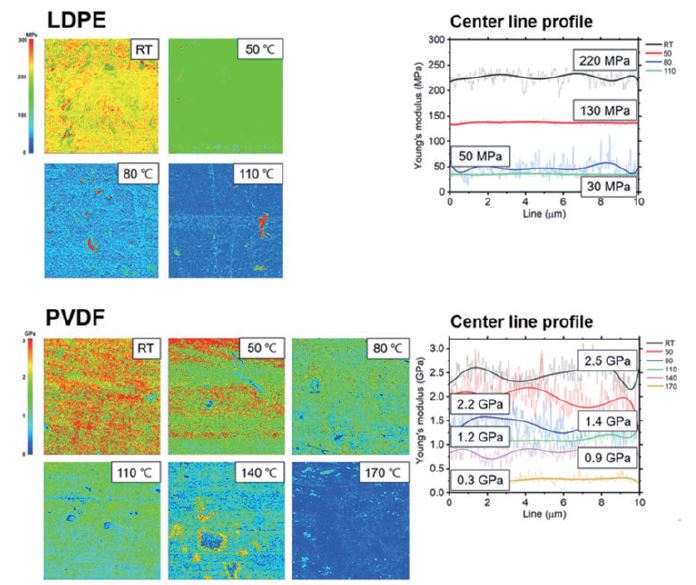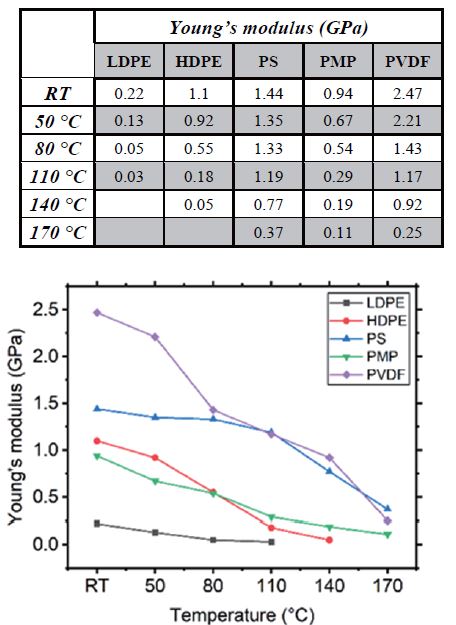Investigating the effect of temperature on Young's modulus of polymer materials through the application of AFM
Introduction
Polymer materials have become increasingly important in various industrial applications due to their unique physical and chemical properties. One of the key mechanical properties of polymers is their Young's modulus, which is a measure of the stiffness or rigidity of a material [1].
Temperature changes can have a significant impact on the mechanical properties of polymers [2]. As the temperature increases, the polymer’s Young's modulus typically decreases, making the material more flexible and less stiff. This is because thermal energy causes the polymer chains to move more freely, reducing their ability to resist deformation under stress [3-5]. Understanding the mechanical properties of polymer materials according to temperature changes is crucial for designing and engineering materials that can withstand various environmental conditions.
In this application note, we explore the effects of temperature changes on the mechanical properties of polymer materials, with a particular focus on Young's modulus using Atomic force microscopy (AFM). Among the modes that can measure mechanical properties with AFM, the average value of Young's modulus was measured by mapping local regions of the polymer surface using the PinPoint™ nanomechanical mode. In addition, a temperature-controlled stage (TCS) was coupled to AFM to track the changes in Young's modulus according to temperature while changing the temperature from room temperature (RT, 25 oC) to 170 oC.
AFM and TCS
The FX40, a newly launched AFM model for research by Park Systems, was used for these measurements. The FX40 is a high-performance AFM model designed for research applications in various fields, including nanotechnology, material science, life science, and semiconductor industries. It offers several advanced features, including high-resolution imaging and a wide range of imaging modes. It also has a high-precision motorized stage that allows for precise sample positioning and scanning.
Park Systems also provides TCS that can be connected to an AFM model to measure the changes in various sample properties the respect to temperature. There are three types of stages which have different temperature adjusting range, stage size and hardware setup. TCS type 1 has a fast temperature change due to active heating and cooling. While TCS type 2 and TCS type 3 increase the temperature quickly with active heating, it may take some time for the temperature to decrease due to passive cooling (Figure 1). Depending on the TCS type, it can be applied from -20 °C to 600 °C. In this test, type 1 was used that can be set the temperature from -20 °C to 170 °C .
Figure 1. Three types of TCS modules of Park Systems.
Result
First, changes in the surface of polyurethane and collagen film according to temperature variation were measured using Non-contact and Tapping mode, respectively. As shown in Figure 2a, temperature fluctuations can affect the surface morphology of polyurethane. With increasing temperature, the surface becomes rougher, whereas at RT, the surface appears smoother. At higher temperatures, the polyurethane undergoes a transition from a crystalline to an amorphous state or from one crystalline structure to another. This transition can result in changes in the material's crystalline morphology, such as a decrease in crystallinity or alteration in crystal size or arrangement [6]. Collagen is a temperature-sensitive material, and its structure can change significantly as the temperature is varied. In Figure 2b, at higher temperatures, collagen film denatures, leading to changes in its structure and surface morphology and phase transition. Denaturation can cause collagen to lose its structural integrity, resulting in a rougher and more irregular surface [7].
Figure 2. Topographical comparison of materials according to temperature change. Height images of polyurethane at RT and 80 oC (a), Height and phase images of collagen film at RT and 100 oC (b)
Next, Young's modulus measurements by PinPoint™ nanomechanical mode were performed according to temperature change for five polymers. As this is a test to measure changes in mechanical properties depending on temperature, low-density polyethylene (LDPE), high-density polyethylene (HDPE), polystyrene (PS), and polymethylpentene (PMP) and Polyvinylidene fluoride (PVDF) were selected in consideration of rigidity and melting point with thermoplastic properties (Table 1). Each polymer was prepared in the form of a 2×2×0.5 cm square film and attached to a metal disk using a thermal compound.
Table 1. Properties of polymers
All five polymers have thermoplastic properties, Young's modulus of 0.1 ~ 3 GPa, and a melting point of 115 ~ 260 oC. Before the measurements, the AFM probe was calibrated for accurate and quantitative results. Figure 3 shows Young's modulus images of LDPE (Relatively low Young's modulus and melting point among the five polymers) and PVDF (High Young's modulus and melting point) as a function of temperature. As can be seen in the Young's modulus images and the center line profile of each image, as the temperature increases, the Young's modulus of the polymers decreases. This trend can also be confirmed in the measurements for all polymers in Table 2 and Figure 4.
Figure 3. Young’s modulus images and center line profiles at different temperatures. Young's modulus values at center line profile indicate that the values decrease as the temperature increases.
At higher temperatures, the mobility of polymer chains increases due to increased thermal energy, which causes the polymer to become more flexible and less resistant to deformation. This increased mobility allows the polymer chains to move more easily and rearrange themselves under stress, leading to a lower Young's modulus. Additionally, at higher temperatures, the intermolecular forces holding the polymer chains together become weaker, which also contributes to the lower Young's modulus. Therefore, the combination of increased chain mobility and weakened intermolecular forces at higher temperatures leads to a decrease in Young's modulus of a polymer.
Table 2. Young’s modulus of polymers at different temperatures. All measurements were performed by PinPoint nanomechanical mode and analyzed by SmartAnalysis (Image analysis program, Park Systems).
Figure 4. The graph of Young’s modulus-Tempurature of 5 polymers. The graphical information shows a similar trend for all polymers.
Conclusion
In this application note, we discuss the effects of temperature changes on the mechanical properties of polymer materials, specifically focusing on Young's modulus. Using an AFM equipped with a TCS, we measured changes in Young's modulus based on temperature for various polymers, including LDPE, HDPE, PS, PMP, and PVDF. As the temperature of a polymer material increases, its Young's modulus typically decreases, making the material more flexible and less stiff.
The properties of polymers can vary depending on factors such as their molecular structure, composition, and processing conditions, including temperature. Studying the properties of polymers with respect to temperature is important for various industries, such as materials science, polymer engineering, and polymer processing, as it can help in developing new polymer materials with tailored properties for specific applications, optimizing processing conditions, and ensuring the performance and reliability of polymer-based products in different temperature environments. Also, researchers and engineers can better understand their behavior and performance under different conditions, and design polymers with specific properties for desired applications.
References
1. Ward, I. M., & Sweeney, J. (2012). Mechanical properties of solid polymers. John Wiley & Sons.
2. Shahabaz, S. M., Sharma, S., Shetty, N., Shetty, S. D., & Gowrishankar, M. C. (2021). Influence of temperature on mechanical properties and machining of fibre reinforced polymer composites: a review. Engineered Science, 16, 26-46.
3. Huang, P. Y., Guo, Z. S., & Feng, J. M. (2020). General model of temperature-dependent modulus and yield strength of thermoplastic polymers. Chinese Journal of Polymer Science, 38, 382-393.
4. Nasraoui, M., Forquin, P., Siad, L., & Rusinek, A. (2012). Influence of strain rate, temperature and adiabatic heating on the mechanical behaviour of poly-methyl-methacrylate: Experimental and modelling analyses. Materials & Design, 37, 500-509.
5. Kendall, M. J., & Siviour, C. R. (2014). Experimentally simulating high-rate behaviour: rate and temperature effects in polycarbonate and PMMA. Philosophical Transactions of the Royal Society A: Mathematical, Physical and Engineering Sciences, 372(2015), 20130202.
6. Arévalo-Alquichire, S., Morales-Gonzalez, M., Navas-Gómez, K., Diaz, L. E., Gómez-Tejedor, J. A., Serrano, M. A., & Valero, M. F. (2020). Influence of polyol/crosslinker blend composition on phase separation and thermo-mechanical properties of polyurethane thin films. Polymers, 12(3), 666.
7. Shanmugam, G., & Polavarapu, P. L. (2009). Structural transition during thermal denaturation of collagen in the solution and film states. Chirality: The Pharmacological, Biological, and Chemical Consequences of Molecular Asymmetry, 21(1), 152-159.





